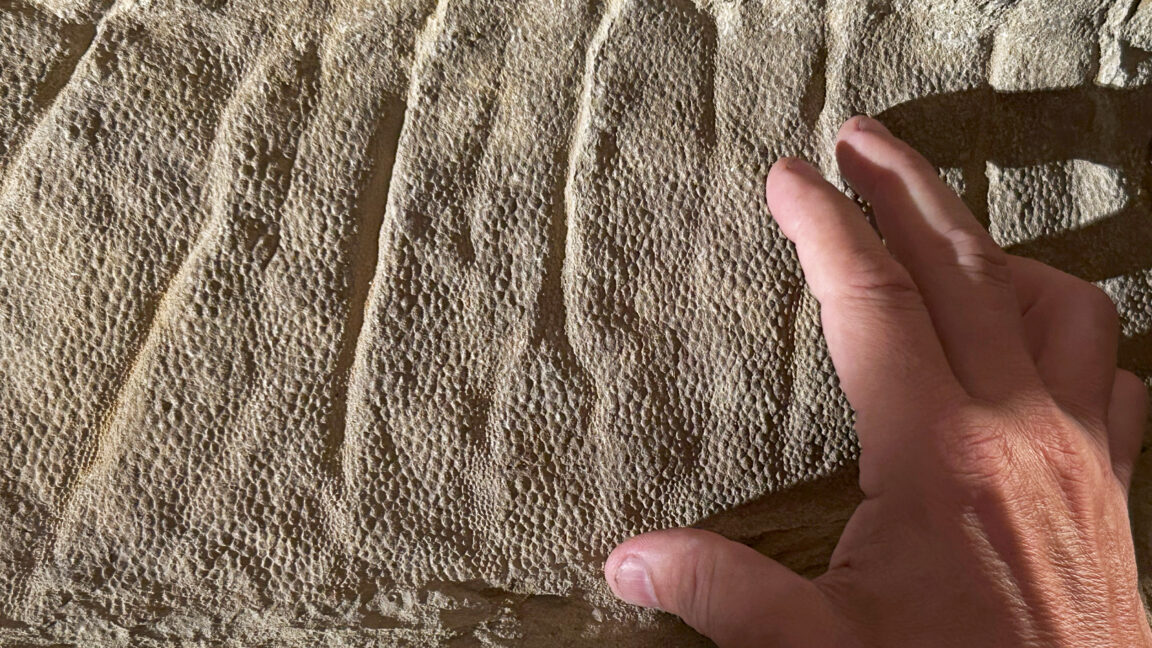Science
Wyoming Unearths Ancient Edmontosaurus Mummies, Reveals Details

A recent discovery in east-central Wyoming has provided a remarkable insight into the appearance of the duck-billed dinosaur, Edmontosaurus annectens. Initially uncovered in 1908 by fossil collector C.H. Sternberg, the first specimen, known as the “AMNH mummy,” showcased a skeleton with imprints of scaly skin. Over a century later, a team of paleontologists led by Paul C. Sereno from the University of Chicago has returned to the same site, uncovering two additional mummies that offer a clearer picture of this ancient herbivore.
The recent findings are significant as they provide unprecedented detail about the dinosaur’s external anatomy, captured in a thin layer of clay. For the first time, researchers have gained insights into the size of the scales and the arrangement of spikes on the tail, challenging previous interpretations.
Redefining Edmontosaurus
The portrayal of Edmontosaurus has evolved over the years, even before Sereno’s latest investigation. The initial representation by paleoartist Charles R. Knight in 1909 was based on incomplete information, leading to an inaccurate depiction of a dragon-like creature. Subsequent reconstructions by notable paleontologist Jack Horner in 1984 also contained errors, as he misinterpreted the skeletal structure.
Sereno’s team retraced Sternberg’s original route to find the mummies, facing the challenge of deciphering notes that referred to locations no longer present on current maps. Through discussions with local farmers, they located the “mummy zone,” a surprisingly rich area for Cretaceous fossils, less than 10 kilometers in diameter.
Unique Geological Conditions
The fossils were found within the Lance Formation, a geological formation dating back to the last three million years of the Cretaceous period. This formation spans several states, including North Dakota and South Dakota, extending even into parts of Canada. Sereno noted that while the formation typically measures around 200 meters in thickness, the mummy zone reaches an astonishing 1,000 meters due to high sedimentation rates.
He attributes this rapid buildup to frequent flooding from a nearby river, which likely buried the dinosaurs under mud and clay, preserving their bodies through a process known as clay templating. This phenomenon creates thin clay masks that capture the external features of the dinosaurs, a method previously recognized mainly in deep-sea organisms.
Recent discoveries included two additional Edmontosaurus skeletons, encased in clay masks less than one millimeter thick. These findings have led to an updated image of the dinosaur, incorporating notable changes based on modern imaging techniques such as CT scans and photogrammetry.
The updated depiction reveals new details about the dinosaur’s features, including a fleshy crest that runs along the spine and a series of spikes, similar to those of modern chameleons. A surprising revelation was the presence of hooves on its legs, suggesting that this trait was not exclusive to mammals.
Further Discoveries and Implications
Sereno’s research not only sheds light on Edmontosaurus but also highlights the discovery of mummies of other species, including a Tyrannosaurus rex and a Triceratops. Preliminary observations indicate that the T. rex mummy may have been buried alive, preserved in a life-like pose, while the Edmontosaurus mummies were likely positioned in a death pose, having died several days before being covered.
The differences in skin structure between the Edmontosaurus and Triceratops, particularly in scale size and thickness, suggest significant physiological variations among dinosaurs that cohabitated the same environment.
Sereno expressed enthusiasm for the future of paleontological discoveries in the region, indicating that the recent findings are just the beginning of understanding the complexities of dinosaur physiology and their ecosystems. The upcoming publications detailing these findings are anticipated to provide even more insights into the lives and environments of these ancient creatures.
As research continues, the implications of these discoveries will undoubtedly enhance our understanding of dinosaur biology and evolution, marking an exciting era in the field of paleontology.
-

 Science3 months ago
Science3 months agoToyoake City Proposes Daily Two-Hour Smartphone Use Limit
-

 Top Stories3 months ago
Top Stories3 months agoPedestrian Fatally Injured in Esquimalt Collision on August 14
-

 Health3 months ago
Health3 months agoB.C. Review Reveals Urgent Need for Rare-Disease Drug Reforms
-

 Technology3 months ago
Technology3 months agoDark Adventure Game “Bye Sweet Carole” Set for October Release
-

 World3 months ago
World3 months agoJimmy Lai’s Defense Challenges Charges Under National Security Law
-

 Lifestyle3 months ago
Lifestyle3 months agoVictoria’s Pop-Up Shop Shines Light on B.C.’s Wolf Cull
-

 Technology3 months ago
Technology3 months agoKonami Revives Iconic Metal Gear Solid Delta Ahead of Release
-

 Technology3 months ago
Technology3 months agoApple Expands Self-Service Repair Program to Canada
-

 Technology3 months ago
Technology3 months agoSnapmaker U1 Color 3D Printer Redefines Speed and Sustainability
-

 Technology3 months ago
Technology3 months agoAION Folding Knife: Redefining EDC Design with Premium Materials
-

 Business3 months ago
Business3 months agoGordon Murray Automotive Unveils S1 LM and Le Mans GTR at Monterey
-

 Technology3 months ago
Technology3 months agoSolve Today’s Wordle Challenge: Hints and Answer for August 19









